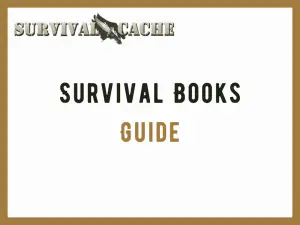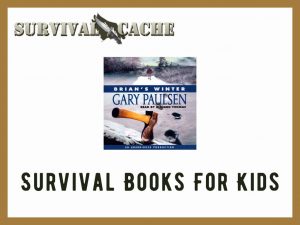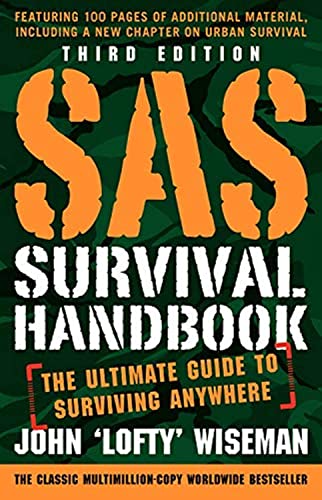
There are a million and one survival books out there and they all claim to teach you how to become Jeremiah Johnson overnight. It’s hard to figure out who to trust and what kind of survival books you should read. Here are 3 types of survival books you should read and why:
SKIP AHEAD
Survival Books: Types You Should Read
1. Military Manuals
I don’t know about you, but I don’t trust the United States government any further than I can throw it. That said, I will still read Military Manuals for survival information. Why? Well because you know it’s battle-tested. The amount of research and testing that goes into creating military manuals is huge.
While a Military Manual certainly isn’t the end all be all for survival situations, at least I know what I am getting. I would rather have clear concise and actionable information from a military manual than get edible plant information and hunting tips from Joe Survival Guy.
WTSHTF it might not be the most brilliant, the easiest, or the quickest – but it probably won’t kill you. (That can’t be said for a lot of “survival books”
Prepper Press has published a number of survival manuals for preppers.
2. Books by Survivalists
What? I just told you half the so-called survival books out there are worthless. Well yea they are, but there are good ones too (One good book on Emergency Preparedness is Making The Best of Basics by James Stevens). You should read books by other survivalists but only if you know them. I don’t mean you have to be on a first-name basis, just know of them. Know their reputation. What are their credentials that might lend to survival knowledge? Do they have a website or blog on which they write useful and intelligent articles? Has another survivalist that you trust recommended the book to you?
I have found that a good rule of thumb is avoid any so called survival book that Barnes and Noble will put on a display just to draw your attention to the title. The SHTF Ultimate Survivors Guide to Zombie Killing and the Armageddon. You know the kind of books I am talking about.
You should read plenty of survival books by other survivalists, but always keep an open mind and know that just because they wrote a book doesn’t mean they are the ultimate survival expert.
3. Fiction
This may sound counter-intuitive to many people. Why should you read fiction to learn about survival? I think reading end-of-the-world fiction books is a great survival resource for expanding your mind.
Good fiction writers can create the most amazing scenarios and situations that you can imagine yourself in. Sure, the actual survival skills used by the characters are often questionable at best, but it is a great way for you to play the “what would I do?” scenarios.
It’s ok if you can think of a thousand better ways to use what is available in the story, or wonder why the main characters aren’t using their heads at all. It gets you thinking and gets you planning outside of your normal thought processes, and maybe even introduces you to a new end-of-the-world scenario you had never considered before.
So keep some good military manuals in your bug out bag for straight skills, read other survivalists for gear ideas and tips, and read fiction to expand your survivalist mindset.
Expert Tip: Make sure to put together a survival library. Such a library can be digital or a physical set of books that will get you by any critical SHTF scenario. Read more about that here.
Best Survival Books For “Adults”
* We assure you that any books mentioned on this site we have read ourselves. Check out our recommendations below:
- Back to Basics: How to Learn and Enjoy Traditional American Skills
- The Survival Handbook: Essential Skills for Outdoor Adventure – By Colin Towell
- Emergency: This Book Will Save Your Life – By Neil Strauss
- When All Hell Breaks Loose - Stuff You Need to Survive When Disaster Strikes – By Cody Lundin
- Hawke's Green Beret Survival Manual – By Mykel Hawke
- Modern Survival Manual - Surviving the Economic Collapse – Fernando Aguirre
- Will to Live – Les Stroud
Best Survival Books For Kids: My 12 Picks

I thought it would also be prudent to make a shortlist of some of the best survival books for kids available in order to keep the next generation interested in something other than electronic devices or video games. Also as a parent or guardian, making your kids understand survival is crucial in any situation. The love of outdoors is a dying trend. Maybe some of these books could spark that interest in kids once again.
1. The Hatchet By Gary Paulson Review

About a young boy named Brian who is on his way to spend time with his father. A plan crash over the Canadian wilderness spoils those plans. He is soon confronted with how to survive with nothing but his wits and the few supplies at hand. NOTE there are many stories by Gary Paulson that have to do with the outdoors, too many to mention for this list. Except for the next title.
2. Brian’s Winter By Gary Paulson Review

Spoiler alert ahead!! At the end of The Hatchet Brian is rescued. But Brian’s Winter is a sequel that follows the young boy on his journey through the cold, difficult months if he hadn’t been rescued.
3. Swiss Family Robison By David Wyss Review

First published in 1812, this tale follows the Robinson family as they leave Napoleon occupied territory. On their journey to New Guinea, their ship becomes damaged and they find sanctuary on a deserted island. Through many exciting adventures they learn to live in the wild and even build an amazing treehouse.
4. Robinson Crusoe By Daniel Defoe Review

Published in 1719 this tale is probably the oldest on the list, but I still remember being intrigued by this book when I first read it in high school. Robinson Crusoe is an age old tale of a young boy who defies his parents and tries to find his place on the sea. He encounters many setbacks in his adventures including bad storms and even becomes a prisoner. However, one last storm proves too much as it shipwrecks he and his crew. Crusoe becomes the sole survivor and must learn to live on a deserted island.
5. Boy Scouts Handbook Review

While not a fiction, the Boy Scouts Handbook has become the foundation for many young people learning outdoor skills. There are several editions, but all are quite good. I would still have my Boy Scouts Handbook if I had not lost it on an outdoor excursion. Kind of fitting.
6. My Side Of The Mountain By Jean Craighead George Review

This was another one of my favorite books as a child. The story follows a young boy, Sam Gribley, who runs away from his home in New York City. In his quest to find a family farm abandoned by his grandfather, Sam finds himself learning how to survive in the wilds of the Catskill Mountains.
7. Island Of The Blue Dolphins By Scott O’Dell Review

This is the true story of Karana, a twelve-year-old girl who becomes stranded on an island off the coast of California. From fighting off predators to fearing seal hunters, she learns to survive for years on the island.
8. Lost In The Barrens By Farley Mowat Review

Two young boys set out on an adventure that proves more dangerous then either one anticipated. After a raging river destroys their canoe, they must work together in order to build shelter, hunt for food and fight off dangerous predators.
9. Incident At Hawk Hill By Allan W. Eckert Review

A Newbery Honor book, this story is an incredible tale of a six-year-old boy who survives for two months after becoming lost in the Canadian wilderness.
10. Gentle Ben By Walt Morey Review
![[(Gentle Ben )] [Author: Walt Morey] [Jan-1992]](https://m.media-amazon.com/images/I/51q9JqJyNEL.jpg)
A young boy named Mark lives in the Alaskan Territory with his family. He sets out to tame and befriend a brown bear, Ben, that has been locked away in a shed for years.
11. Where The Red Fern Grows By Wilson Rawls Review

Heartwarming and a bit of an emotional rollercoaster. This is a tale of the bond between a boy and his dogs. Centered in the Ozark Mountains, a young boy named Billy saves up all of his money so he can purchase two coonhounds. It doesn’t take long for everyone to realize Billy has trained the best hunting dogs in the area.
12. SAS Survival Handbook By Lofty Wiseman Review

This title certainly isn’t aimed towards children but I wanted to add it to the list for its straightforward descriptions and abundant drawings/diagrams. This would definitely be a good guide for slightly older kids looking to expand outdoor and survival knowledge.

